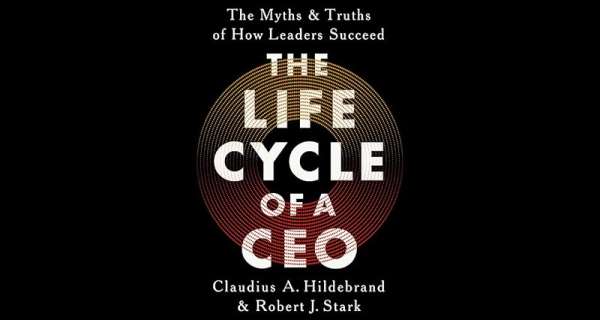
This content is based on an article about "leadership" on Forbes.
We encourage you to read the book "The Life Cycle Of A CEO," written by Claudius Hildebrand and Robert Stark. Thanks
Episode 1: https://kenkavn.com/news/unpredictable-tenures-the-complex-reality-of-ceo-longevity-episode-1-304
This is the Episode 2.

Hildebrand: Many people think leaders are special. They believe that when someone becomes a leader, they suddenly know everything. This is not true. They're wiser, they're funnier, they're taller. This is the way we portray these leaders in the media. It's also the way we as a society want to see these leaders. We don't want a leader who doubts themselves. That's doesn't make us feel very confident. It's also in the advice that's currently out there leaders: This idea that you have to have these four traits, or these five behaviors and these six mindsets. What we find time and time again is when we work with executives and CEOs and advise we [find there and some] who question their decisions, who have to rely just as much on gut as they have to rely on information. And to Bob's point around this idea of continuous growth, we found there's no model of leadership that focuses on a set of growth or development stages.
But at the same time, you never step into the same river twice. Just because someone is the leader doesn't mean that they don't change over time. And that's what we found. The challenges that leaders face might have similarities, but they manifest themselves differently depending on where one is in their tenure, and then where one psyche is in those moments. The book's not only about what CEOs do to be great, but it's also how leaders feel along that journey.
Going through the different stages of the CEO's life cycle, as well as the before and after periods, is there any one area that you think CEOs or other leaders should be taking a closer look at and reassessing how they are responding to challenges?
Stark: My initial response is that across the life cycle, every one of these stages, there's a critical moment for self-reflection. It can happen in the first year. There are moments in a CEO's first year, there are moments pre-CEO, there are moments when you're the new CEO, where if you're not reflecting on where you're at, what you're doing and what comes next, you can run into problems.
The place that we really shine a light on where people can get sideaways is in the second year in the calibration, which we sometimes talk about as a "sophomore slump", which is decline in performance that can sometimes occur in the second year or "sophomore" year of a business. You've got to be ready at every turn for what is next and how stakeholders will be viewing you, given their expectations at every stage.
For most CEOs, before we started writing about this, a moment of reinvention that was really unknown is when they get to that year three through five and they're doing really well, they kind of have a sense that, "Oh, I've figured this out. I'm good at this now. My team is humming (busy). People see the results that I've created in the moves that I've made earlier." It's very easy at that point to settle in.
I remember when we first talked to CEOs about our findings years ago, I was in front of a big group, and a CEO put up his hand and said, "Every role I've been in before CEO was three to five years, so I never had to reinvent in place. I'm in year five right now, and I'm trying to figure out how do I start over in this role?" That's a huge moment because people are used to: I get a new role, I figure out how to do that, create some value, get the new team going.
If you want to go beyond 5 years, you need to reinvent yourself from within, without relying on outside help.
Hildebrand: There's so many different points in time to highlight that it's really hard to single out any one of them. Leaders who use the life cycle as a framework, I think that's the benefit of it: to identify where, for you personally, you might see that challenge. It's a lot about foreseeing the challenges. This idea of anticipating what might happen next, and then taking the right actions to avoid potential problems.
You broke out the experience of a CEO in a private-equity-owned company into its own chapter. What made you decide to address it that way?
Hildebrand: Private equity is a really interesting place. Where you think about it as a sector, it's only been around about 50 years. These days, there's more privately held companies than publicly held companies. It's a really important part of our economy that we did what to address.
We did find significant differences in that sector that are different from the public sector. Holding periods in private equity have increased. It used to be more like three to five years. These days, the average holding period is close to seven years. What can they learn from each other to get better? What we hoped to do in parts of that chapter is compare and contrast a little bit.
One thing that we found that one can learn from the other is private equity has a really interesting governance model. We talk about it in the leadership triad. In a public company situation, boards are far removed from the inner workings of an organization, and the CEO is in the middle of this holding the power. When information flows and doesn't flow from one or the other, much depends on that one individual.
In private equity, you see a triangle where deal sponsors and boards work closely with executives. Often, operating teams also report to the board and CEO. The CEO sits in the middle of this triangle, managing information flow. This setup may seem simple, but it's key to social networks. Leading in this environment is unique. Private equity allows information to move more freely, unlike the formal, slow-paced public company board meetings. This quick flow has many benefits. Public companies could learn from this to improve their governance. The private equity model avoids delays and allows for faster decision-making. By adopting some of these practices, public companies might streamline their processes and become more responsive to market changes.
On the other hand, private equity is running into a fundamental challenge. It's very difficult to quantify the ROI on investments into talent, and they're running on a very strict scenario plan over a seven-year period. Any day that you wait to invest in talent, you're losing the half-life of the return on investment. But at the same time, the way that private equity has developed, it's no longer about the leveraged buyouts and loading a balance sheet full of debt and selling it off in a mater of months or years. Leadership is the next frontier, and the best private equity companies understand that, but they're still struggling with how do you develop leaders internally, and how do you set them up for success in the same way that some of the iconic companies that are in the public realm have done.
If there's one lesson, story of example you would like readers to take from your book, what would it be?
Stark: The CEO Job is interesting to study because it's so complex. But the complexity of the role also reveals that for all of us, even in roles less complex, we shouldn't assume that the role that we're in is static. It actually unfolds over time around us. In any job that we have to do, our particular job is to develop and adapt as the job is unfolding, notice how it's unfolding and be adaptive to that unfolding. That's what happens to CEOs. Those who figure out how to adapt and grow in the role can thrive, and those who don't struggle mightily.
Hildebrand: Challenges exist at every stage. What's different is how they manifest themselves throughout the progression of tenure. If we think about our personal lives and the challenges that we think about our personal lives and the challenges that we encounter in our 20s and 30s and 40s and 50s, they're very different.
Back to this idea of how do you anticipate how to be prepared for those moments and have the ability to reflect on it, that's a key element in all of this. This understanding of evolution over time and growing together within.
For a new CEO stepping into the role, the amount of information that's thrown at them, we all say it is like drinking from the firehose. You don't know what is important and what is urgent. Everything seems to be important and urgent. How to deal with this? That's a very different challenge than what some of the veteran CEOs, those who has significant experience leading a company, might feel when they've been in that role for 12, 15 years, when they feel like they no longer have real access to information. The team, at this point, thinks they know it all. They are now in a kind of place where it's difficult to see outside. It's like an echo chamber, where the same ideas keep repeating.
What's constant is the importance of information, but how the challenge manifests, it's very different. Understanding where one is on one's journey, and how all these different challenges manifest themselves, that's hopefully the big contribution to anyone reading the book, as they work on taking their game to a higher level.
Is there anything else you want to add?
Hildebrand: It feels often from outside that we look at organizations as these rational, logic-driven places. Fundamentally, what we encountered day-in and day-out, is that we're all human beings. Many of those challenges are as much psychological and sociological challenges as they are economic challenges. What we hope for this book is not obly to help leaders anticipate challenges and get better at it, but it's also an attempt to showcase what it feels like. The job is lonely, but [we wanted to] provide a platform to see, you're not alone in this.
Any other leader is facing these challenges, regardless of their confident public persona. Their composed stage presence doesn't negate potential inner turmoil. They may be wrestling intensely with personal doubts and uncertainties about how to take that inner game forward.
___
... please come back to continue watching the remaining exciting part.
Credit: Thanks to Ms. Megan Poinski https://www.forbes.com/sites/meganpoinski/ on her post https://www.forbes.com/sites/meganpoinski/2024/10/21/a-new-book-shows-why-ceo-tenures-dont-follow-an-expected-narrative/





















0 Comments